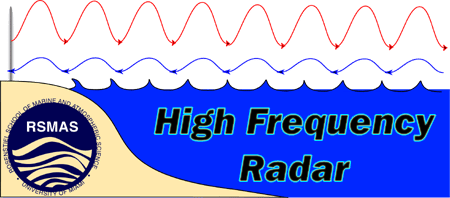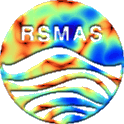 |
|

|
|
Development of High Frequency (HF) radar to measure the ocean's surface has
allowed significant advancement since its inception in the 1950s.
Essentially, a HF radar station transmits an electromagnetic wave of 6 to 50
MHz which is propagated as a ground wave along the sea surface, which due to
its salinity is almost a perfect conductor at these wavelengths. The
transmitted wave is scattered by the ocean surface, and the Doppler spectrum
of scatter from ocean waves of half the transmitted wavelength (Bragg wave)
are recieved by the HF radar station and provide the basis for determining
ocean surface measurements (surface current, wave height, wind direction).
Here is a cartoon of the concept from Klaus-Werner Gurgel.

© Klaus-Werner Gurgel, University of Hamburg, Germany
The University of Miami uses the WERA
HF radar system.
The WERA system transmits a frequency modulated continuous wave
(FMCW) chirp and
avoids the 3 km blind range
in front of the radar (Essen et al., 2000).
The horizontal resolution of WERA is a function of the
the chirp characteristics as listed in the Table~2 for both a high-resolution
and low-resolution version. For a transmission frequency of 16 and 30 MHz,
Bragg wavelengths are 9.4 and 5 m, respectively. The transmitter
is arranged to encompass about a 60 deg swath.
WERA also has the flexibility to be configured into a DF
array (such as CODAR) where 4 antennae may be set up in a square or
a linear array can be set up consisting of 4n
antennae or channels using BF techniques.
According to representatives from the company, a long-range, high horizontal
resolution version can be designed where the range would be O(100 km) and the
horizontal resolution would be 600 to 750 m. This higher spatial resolution
requires bandwidth of 200 to 250 KHz, and approval from the
Federal Communication Center (FCC).
Temporal sampling can be as low
a few minutes as the system is FMCW as opposed to a pulsed
radar (i.e. OSCR). This sampling feature make WERA particularly attractive in
high current gradient regimes where time scales of surface current variability
are less than an hour.
|
Capabilities of the WERA system
| |
High-Resolution | Long-Range |
|
Operation range (km from radar site) | 45 | 80 | |
Range cell resolution (km) | 0.3-0.6 | 0.6-1.2 | |
Measurement depth (m) | 0.4 | 0.8 | |
Measurement cycle (min) | < 10 | < 10 | |
Radial current (cm s -1) | 2 | 2 | |
Vector current (cm s -1) | 5 | 5 | |
Vector direction (°) | ± 3 | ± 3 | |
Operating frequency (MHz) | 30 | 16 | |
Transmit elements (Yagi) | 4 | 4 | |
Receive elements (BF) | 8-32 | 8-32 | |
Receive elements (DF) | 4 | 4 | |
Transmitter Peak Power (W) | 30 | 30 |
|
|
|
| Please email jmartinez@rsmas.miami.edu with any questions or comments.
|
|



